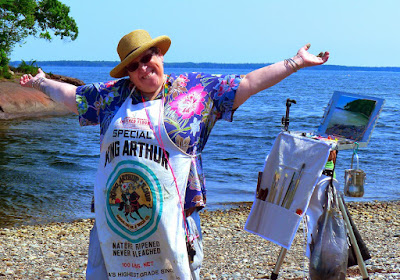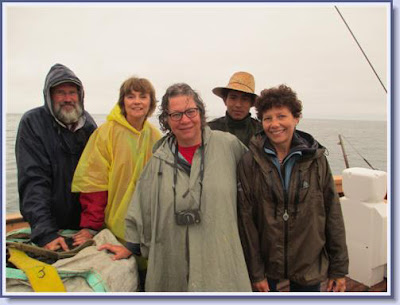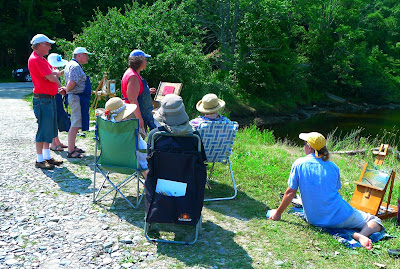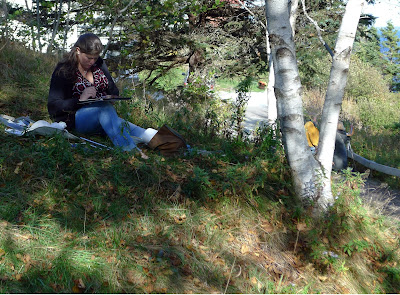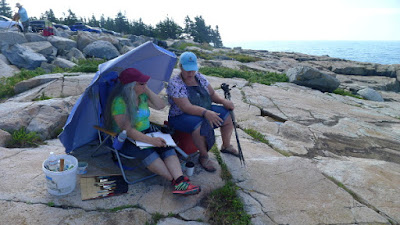Four options for advancing your skills in 2021.
 |
| Painting aboard schooner American Eagle. |
A workshop or a class is a great gift for someone who’s working toward better painting skills. If you register for any of these workshops or classes prior to January 1, you’ll get an early-bird discount.
All my workshops and classes are strictly limited to 12 participants. Partners are welcome; these locations are fantastic destinations in their own right. And, of course, you can register after January 1, but it will cost you more.
I’m assuming that COVID will be just a bad memory by 2021, but if not, all workshops are refundable for COVID cancellations.
 |
| All supplies are included in the schooner workshops. Also a healthy dose of color theory. |
PAINT ABOARD SCHOONER AMERICAN EAGLE—June and September
We’re offering Age of Sail aboard schooner American Eagle twice in 2021. It’s an all-inclusive (including materials) rollicking sail-and-paint class aboard the finest windjammer on the Maine coast.
The June sail coincides with the Gam, a rendezvous of all the boats in the Maine windjammer fleet. There’s live music and visiting between boats. The lobster fleet is hard at work, and we’ll see lupines in bloom as we poke around Penobscot’s quaint harbors.
On the other hand, September is a delightful time to sail on the Maine coast. The ocean is still warm, and the colors are spectacular.
All the information you need about both trips can be found here.
 |
| Painting at breathtaking Schoodic Point in Acadia National Park. |
SPEND A WEEK AT INSPIRATIONAL SCHOODIC INSTITUTE IN ACADIA NATIONAL PARK—August
My Sea & Sky workshop is a perennial favorite and one of the high points of my year. We paint in the splendor of America’s first national park, but far from the madding crowds.
Schoodic Peninsula has dramatic rock formations, windblown pines, pounding surf and stunning mountain views that draw visitors from around the world. You might see dolphins, humpback whales or seals cavorting in the waves. Herring gulls visit while eiders and cormorants splash about.
A day trip to the harbor at Corea, ME is included. Far off the beaten path, Corea, ME is a village of small frame houses, fishing piers and lobster traps. Its working fleet bustles in and out of the harbor.
Again, it’s designed to be all-inclusive so that you don’t have to stop and figure out meals or drive in from your hotel. (They’re in short supply in the high season here in Maine.)
Information about this trip can be found here.
 |
| Painting in an historic settlement near Pecos, NM. |
VISIT THE PRISTINE WILDERNESS OF PECOS, NM—September
A fast-moving river, high mountain vistas, hoodoos, dry washes, tiny settlements and the colorful skies of New Mexico all beckon us to this very special place.
The village of Pecos, NM lies below the Santa Fe National Forest. Nearby, Pecos National Historical Park, Glorieta Pass, and Pecos Benedictine Monastery provide superb mountain views. Ranches and small adobe settlements dot the landscape. This is a landscape of pine wildernesses, horses, and pickup trucks. Yet it’s within commuting distance of Santa Fe, so accommodations, necessities and world-class galleries are just a short drive away.
Information about this workshop can be found here.
 |
| We have almost as much fun on Zoom as we do in real life, except nobody falls in the water. |
Or PAINT FROM THE PRIVACY AND SAFETY OF YOUR HOME
Zoom classes are offered Monday nights and Tuesday mornings. They resume the second week of December. The six-week session stresses all the elements of painting we cover in workshops and plein air classes, but you can access them from anywhere in the world. Returning students have priority, so seats are limited. If you’re interested, contact me soon.
NEED MORE INFO?
First, read the links on my website. Registration is fast and easy and can be done by mail or phone. Of course you can always email me with specific questions. And happy holidays, my friend!







